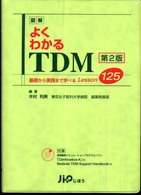- ホーム
- > 洋書
- > 英文書
- > Business / Economics
Full Description
Leisure Services Management prepares students for the challenges they'll face as entry-level recreation and leisure managers. The book outlines the essential knowledge and skills that successful managers need to have and helps students build those competencies by encouraging them to think as managers. The text's activities, projects, and examples help students connect the competencies to real-world situations.Leisure Services Management begins by presenting a firm foundation of competency-based management theory. Students will learn what management is, what the manager's role is, and how their work affects their agency and their customers. They will also explore specific management areas such as marketing, financial management, human resources, employee development, communication, and evaluation. Throughout the text students will be encouraged to apply their own experiences to the concepts being discussed to deepen their understanding of the profession.For each chapter, the authors provide experiential learning activities that simulate real on-the-job situations. Each of the activities asks students to assume one of the many roles of a new manager. They'll learn to deal with day-to-day management activities by completing work assignments and projects similar to those they'll assume as a manager. The activities will help students develop the competencies they'll need in order to meet the challenges of this evolving field.Following are some of the student-friendly features in Leisure Services Management:-A competency scorecard that will help students gauge their progress as they work through the text-Numerous examples drawn from the public, nonprofit, and commercial sectors in the United States and Canada-Unique "A Day in the Life" sidebars in each chapter, which relay the stories of new managers currently working in the field-Practical, real-world activities and projects that reinforce concepts and encourage a managerial mind-set-Review questions useful for analyzing and applying content-A running glossary for quick reference to new terminology within the textThe text also includes access to an online student resource (OSR), which provides documents and forms sampled from the actual files of leisure managers to assist students in understanding and using important management tools. The OSR also includes an overview of key concepts by chapter, one or more detailed case studies for each chapter, a glossary, Web links, and the competency scorecard, detailing the competencies required for entry-level professionals. Using this scorecard, students can measure their management skills, knowledge, and abilities at the outset of the course and reevaluate their progress at end of the course.The competency-driven approach of Leisure Services Management assists readers in gaining the knowledge and practicing the skills they need in order to begin their career in leisure management. Bolstered by the practical information in Leisure Services Management, new managers can contribute to the success of their organization as they enjoy the challenges and rewards of their new position.
Contents
Chapter 1What Is Management?Competency-Based ManagementConclusionChapter 2: Foundations of ManagementLeadership as a DisciplineManagement as a DisciplineManagement TrendsConclusionChapter 3: Leisure Services ManagersLevels and Functions of ManagersResources to ManageCareer Progression of ManagersManagement DriversEfficiency and EffectivenessConclusionChapter 4: Legal Foundations for ManagersCurrent Legal Issues and TrendsOverview of Key Legal ConceptsApplications to Leisure Services Management Legal Issues in EmploymentConclusionChapter 5: Organizational StructureThree SectorsOrganizational Structure, Design, and CultureWorking With BoardsForm of Government and Organizational Structure and DesignConclusionChapter 6: Coordination of Resources, Programs, and ServicesInternal Organizational CoordinationExternal Organizational CoordinationConclusionChapter 7: Planning and Decision MakingPlanningDeveloping a Technology PlanProblem Solving and Decision MakingEthical Decision MakingConclusionChapter 8: Marketing and Public RelationsDefinition and History of MarketingMarket Segmentation and Target MarketingMarketing MixPublic RelationsConclusionChapter 9: Communications and CustomersFunctions of CommunicationCommunication ProcessCommunication BreakdownsStrategic Approach to CommunicationInternal CommunicationExternal CommunicationConclusionChapter 10: Personnel Procedures and PracticesHuman Resources PerspectivesPersonnel PlanningPersonnel ProcessesManaging VolunteersConclusionChapter 11: Motivation, Rewards, and Discipline Employee DevelopmentMotivationReward SystemsRewarding VolunteersRewarding YourselfDisciplineConclusionChapter 12: Sources and Methods of FinancingSources of RevenueExpendituresPricingPricing Trends and IssuesConclusionChapter 13: Budgets and Financial Cost AnalysisDefining BudgetsBudget CycleCutback ManagementTypes of BudgetsApproaches to BudgetingBudget ImplementationFinancial Analysis and ReportingConclusionChapter 14: EvaluationWhy Evaluate?Types of EvaluationFive-Step Evaluation ProcessSelecting Evaluation ParticipantsBest Practices and BenchmarkingConclusion







